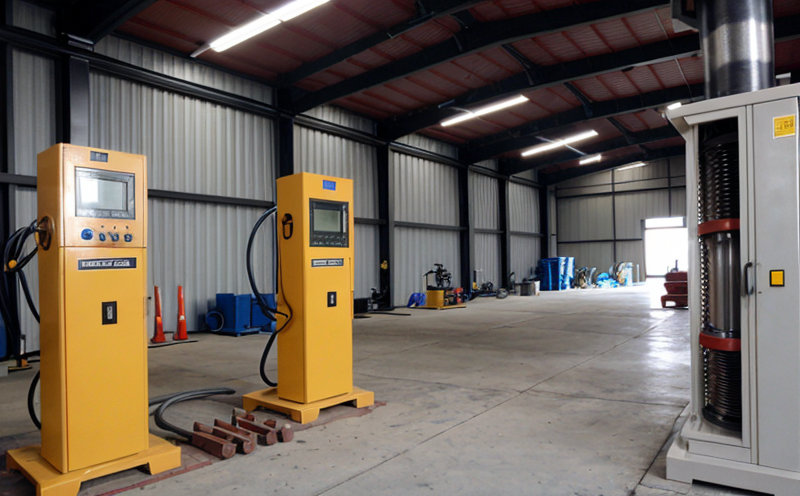ASTM D999-15 Vibration Testing at Different Frequencies
The ASTM D999 standard provides a method for determining the mechanical strength of flexible container units when subjected to cyclic vibration. This service is particularly relevant in industries such as pharmaceuticals, food and beverage, and consumer goods where packaging integrity is crucial during transportation and storage.
When conducting ASTM D999-15 vibration testing at different frequencies, several parameters must be carefully controlled to ensure accurate results:
- Vibration Frequency Range: The frequency range for the test can vary based on the expected operational environment of the packaging. Common ranges are between 20 Hz and 400 Hz.
- Vibration Amplitude: Typically, the amplitude is set at a level that simulates real-world conditions, such as road vibrations during transportation.
- Duration of Test: The duration can be adjusted to match the expected lifespan or operational period of the packaging.
- Environmental Factors: Temperature and humidity may also need to be controlled to simulate real-world conditions.
The testing process involves placing a sample of the flexible container unit on a vibration testing machine. The machine then applies cyclic vibrations within the specified frequency range, amplitude, and duration. During this test, it is crucial to monitor the structural integrity of the packaging. Any signs of damage or failure during the test indicate that the packaging does not meet the required standards.
Preparation of the specimen is critical for accurate testing results. The container unit should be filled with a representative sample weight and sealed according to the manufacturer's specifications. Proper labeling ensures traceability throughout the testing process. It is also important to ensure that the test machine is correctly calibrated before starting any tests.
| Standard | Description |
|---|---|
| ASTM D999-15 | Determines the mechanical strength of flexible container units subjected to cyclic vibration. |
| ASTM D4738-06 | Standard practice for conditioning, packaging and storage of pharmaceutical products. |
The results of this test are vital for quality assurance and compliance. By ensuring that the packaging can withstand cyclic vibrations without failing, manufacturers can enhance product safety and extend shelf life. This testing is especially important in sectors where transportation conditions vary widely or where the packaging must protect products over extended periods.
Understanding the implications of different vibration frequencies on packaging integrity helps in optimizing design and material selection. For instance, higher frequency vibrations might require more robust materials to prevent premature failure during transit. Conversely, lower frequency vibrations may necessitate different types of cushioning within the packaging to absorb shocks effectively.
Applied Standards
The ASTM D999-15 vibration testing standard is widely recognized for its rigorous approach to evaluating the mechanical strength of flexible container units. The following standards are applied:
| Standard | Description |
|---|---|
| ASTM D999-15 | Determines the mechanical strength of flexible container units subjected to cyclic vibration. |
| ASTM D4738-06 | Standard practice for conditioning, packaging and storage of pharmaceutical products. |
The ASTM D999-15 standard is particularly important as it provides detailed procedures for setting up the test environment, preparing the specimens, conducting the vibration tests, and interpreting the results. Compliance with these standards ensures that the testing process is consistent and reliable across different laboratories.
The ASTM D4738-06 standard complements the mechanical strength testing by focusing on environmental conditions that can affect packaging performance. This includes temperature and humidity controls during storage and transportation, which are critical factors when evaluating the long-term stability of flexible container units.
Benefits
The benefits of ASTM D999-15 vibration testing at different frequencies extend beyond ensuring product safety; they also contribute to cost savings and enhanced customer satisfaction:
- Enhanced Product Safety: By identifying potential weaknesses in packaging design early on, manufacturers can prevent costly recalls and ensure consumer safety.
- Cost Savings: Optimizing the materials used for packaging through rigorous testing reduces unnecessary expenses associated with over-engineering or using excessive materials.
- Improved Customer Satisfaction: Packaging that withstands cyclic vibrations without damage ensures that products reach their destination in pristine condition, thereby enhancing customer satisfaction and brand reputation.
- Regulatory Compliance: Meeting the requirements of ASTM D999-15 helps manufacturers comply with regulatory standards, avoiding potential fines and legal issues.
- Innovation Opportunities: Understanding how different frequencies affect packaging performance can lead to innovative designs that better protect products during transportation and storage.
- Environmental Impact Reduction: Optimized packaging design leads to reduced waste and a smaller carbon footprint, contributing positively to environmental sustainability efforts.
- Operational Efficiency: Reliable testing ensures that production processes are not interrupted by failed packaging units, improving overall operational efficiency.
In summary, ASTM D999-15 vibration testing is an essential tool for ensuring the mechanical strength and durability of flexible container units. It plays a pivotal role in maintaining high standards of quality assurance and compliance across various industries.





